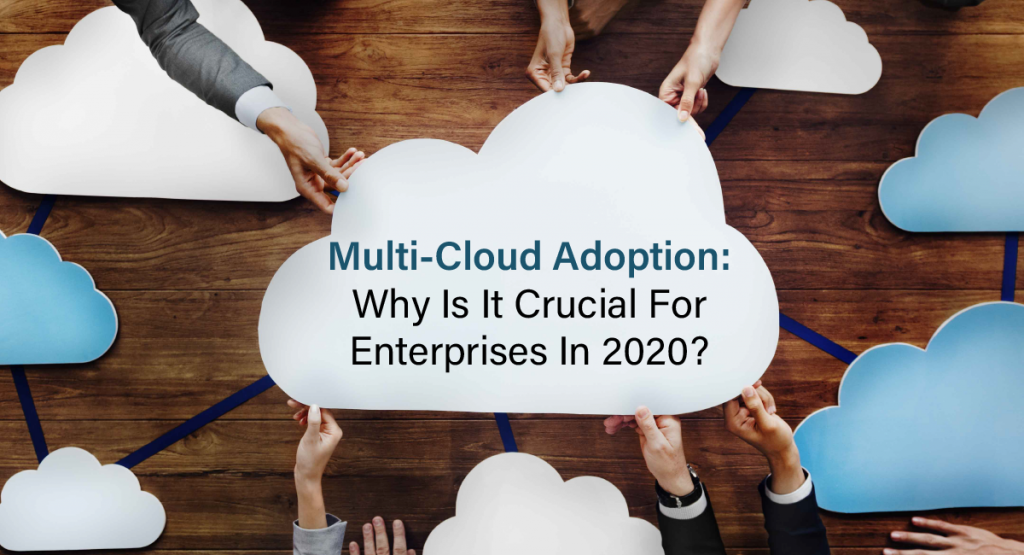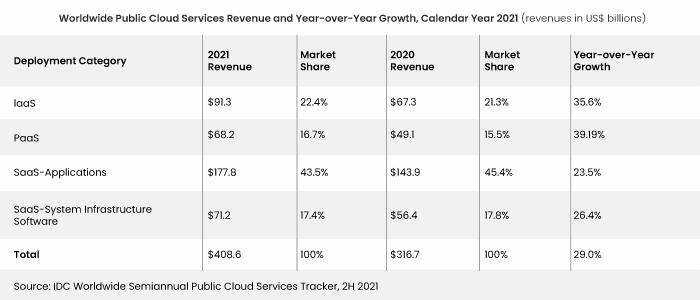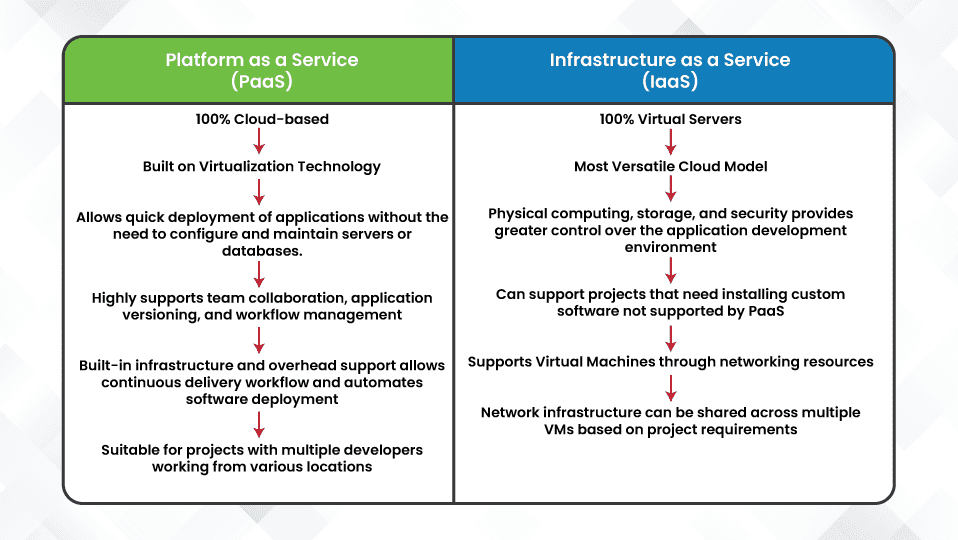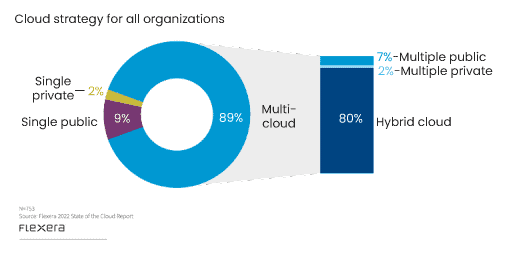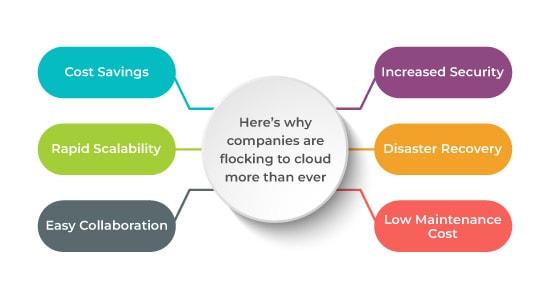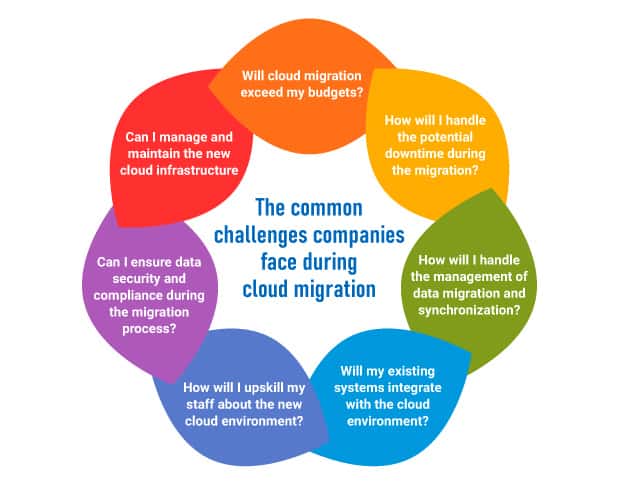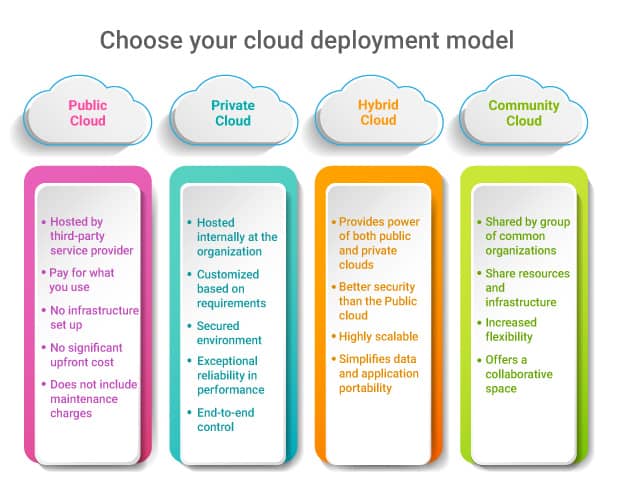Tag: Cloud
The cloud approach is gaining immense popularity amongst businesses due to its scalability, enhanced productivity, and cost-effectiveness. According to Cisco, in 2021, over 94% of workload and computing processes will be hosted on the cloud. While many firms are already implementing and thriving with the Cloud, a few still remain to deploy this technology. This blog is a simple guide to help you understand every aspect of the Cloud, and how your business can drive success with Cloud Application Development!
What’s Ahead?
- Knowing the Cloud!
- What is a ‘Cloud-based Application’?
- Benefits of a Cloud App
- Types of Cloud Application
- Key Features to Consider When Developing a Cloud Application
- Some Examples Of Cloud Application
- Developing a Cloud Application
- A Look at the Tools to Build Cloud-based Apps
- Challenges of Cloud-based Application Development
- A Few Common FAQs
- Conclusion
Knowing the Cloud!
In simple terms, the cloud refers to software or service that is accessed over the internet. The cloud uses data centers to store data, which enables easy access of files and applications from anywhere and from any device.
For businesses, leveraging cloud technology can immensely reduce IT costs and overhead, eliminating frequent updates and maintenance of servers. Cloud computing can also simplify international operations for companies by allowing seamless access and control of files and data from anywhere. Google Drive, Dropbox, Apple iCloud, and Microsoft OneDrive are some widely used cloud services today.
Read more: Why It’s Time to Embrace Cloud and Mobility Trends To Recession-Proof Your Business?
What is a ‘Cloud-based Application’?
In the last decade, cloud computing has experienced a tremendous investment. By the end of 2023, the global cloud market is estimated to reach over $ 623 billion.
Typically, a cloud-based app is an Internet-run program having its components stored online with some or all of its processes carried out in the cloud. These on-demand services allow you to access computer networks, storage, or resources using the internet.
Cloud-based solutions help businesses augment capacity, scalability, and functionality while at the same time reduce maintenance and cost for computer infrastructure or in-house teams.
Common solutions provided by cloud-based applications may include;
- File storage and sharing
- Order entry,
- Inventory management
- Word processing
- Customer relationship management (CRM)
- Data collection
- Financial accounting features
Benefits of a Cloud App
The cloud is creating a huge impact on businesses. According to Gartner, over 60% of companies will majorly rely on the cloud for their operations by 2022. Of course, this means that the cloud has some huge benefits to offer for businesses. Here are a few to highlight.
1. Improved data sharing and security
The data stored in the cloud is easily and instantly available to authorized users. Since the cloud offers easy availability of data, security and privacy are often a concern. That is why the advancements in cloud technology have majorly focused on providing enhanced data security. Many cloud providers now guarantee improved data security, making the cloud the best source for secure storage. Also in case of disaster recovery is inevitable, the cloud provides a streamlined solution to restore and back up data.
2. Improved collaboration
Cloud-based apps and software enable organizations to make collaboration an easy and effective process. These applications provide easy data sharing and editing options allowing employees to work effectively on projects remotely and in real-time. Role-based access control enables better monitoring of tasks, and improves team management, especially when operating remotely. Improved collaborations can help enterprises to reduce time-to-market and enhance customer service. Infince is a prime example of how enterprises can use a cloud-based app to improve team collaboration. The app provides centralized management, enhanced visibility, and easy communication that drives operational efficiency and productivity.
3. Cost-effective
The cloud space can be scaled up or down depending on your business needs. Cloud service providers allow you to pay per usage of the cloud infrastructure allowing you to only pay for the services you need. Most cloud providers offer seamless concierge support and regular maintenance, which in turn immensely helps reduce the stress and cost of maintenance. Moreover, there is no need to invest separately on devices to store data, as the cloud ensures safe and secured data storage. Put simply, cloud-based apps help enterprises reduce the upfront cost of the IT infrastructure and hence are a cost-effective solution.
Types of Cloud Application
To proceed with cloud application development, you will have to decide what type of app you would want to create. One way to classify the categories is about the differences in the app architecture.
SaaS – Software as a Service
SaaS serves both cloud apps as well as individuals. These apps run on third-party hardware and not on the user’s device. Also, the software is hosted remotely. A big advantage of SaaS is that you don’t have to spend on additional hardware or buy licenses for every software update.
IaaS – Infrastructure as a Service
This type of product often requires middleware and app support from the clients. The customer may have to create a custom programming bridge between the application and its operating system. However, with IaaS, one can develop a customized product without building the basic components from scratch.
PaaS – Platform as a Service
This cloud-based app development requires the application code from the customer. PaaS providers allow their customers to use their hardware and basic development software. As this software is updated constantly, developers can use only its latest version. PaaS is flexible and lets the users scale the product as per their needs. Cost efficiency and flexibility are some of the major benefits of PaaS.
Read more: Cloud Migration Strategy: 7 Steps to Accomplish a Flawless Transition
Key Features to Consider When Developing a Cloud Application
The Cloud is a powerful technology, which if leveraged the right way can do wonders for your company. That is why it is imperative to be clear and sure of what benefits you need exactly to derive out of the cloud application development. Here are a few things to consider when fixing the features of your cloud application.
One of the most eminent features of the cloud is that it provides ample space for flexibility and scalability. With the cloud, one can empower safe storage of data that can be expanded as per convenience.
Most users prefer the cloud because of its storage facilities. However, its security is always a concern. When investing in cloud application development, one must highly prioritize app and data security by ensuring a code-based architecture for improved security.
Although the cloud delivers unlimited benefits, cloud hosting comes with a cost. Thus, data size optimization and condensed user requests should be the top priorities while developing a cloud platform.
To ensure you attain maximum benefits from these and the many other features of the cloud, it is imperative that you partner with developers who are highly aware and experienced with the diverse cloud platforms so that you attain software that perfectly suits your business needs. Moreover, following an agile method of development would allow you to collaborate better with your developers, programmers, designers, data architects, and QA managers for improved development efficiency. At Fingent, we ensure client participation at every stage of app development.
Some Examples of Cloud Application
Most of the apps we use today, utilize the cloud in one way or another. Cloud application development has given birth to some amazing tools and services that make operating businesses a little less stressful. Here are a few to point out!
- Infince: Provides streamlined and simplified IT Infrastructure, centralized management, enhanced work collaboration, access to unlimited productivity tools, all under a single platform.
- Dropbox or Google Drive: This allows you to store your files on the cloud easily and help others access them from anywhere.
- Figma: This powerful cloud-based design app is gaining popularity due to its collaborative nature.
- Miro: This provides a virtual board that enables you to work with other users in creative and fun ways.
The possibility to collaborate with users from all over the world, even in real-time is one of the biggest advantages of cloud apps.
Read more: Infince – Untangling Technology for Businesses
Developing a Cloud Application
Cloud application development involves different stages, each of which matters to enable your app to hit the market. Most cloud application development teams use DevOps practices and tools such as Kubernetes to ensure an effective and successful project.
At Fingent, we analyze your business needs and custom-build apps that solve your business complexities. We can help you seamlessly transit to the cloud and efficiently deploy its benefits to achieve greater business growth and value.
A Look at the Tools to Build Cloud-based Apps
A wrong tech approach can slow down your business development, so the technological stack is of utmost importance when developing cloud-based apps. You can choose a cloud service vendor from market leaders such as;
- Amazon Web Services(AWS) – In 2019, it obtained a 32% market share and became the leading provider. AWS includes over 140 flexible and integrative services. This allows you to build almost any custom app.
- Google Cloud Platform – As a PaaS, it offers you cloud computing, API services, advanced analytics, storage, NoSQL database service, and even virtual machines. It is flexible, affordable and a great platform for start-ups.
- Microsoft Azure- Its solutions are designed for enterprises looking for scaling or having many web products. Its services may include ML modules, mobile back-end, database services, and virtual machines.
Cloud-based app structure
- Another aspect to consider when cloud application development is the data architecture. A cloud app operates as a collection of interconnected services or APIs. So, to get maximum benefits of cloud services, you will have to connect them and at the same time understand the kind of components you have while ensuring that those services are integrated.
- Next, you must consider data organization. Remember, the app architecture must instruct the cloud services about how to decouple the data. This will help you store the app components either on a public or private cloud. As a result, your business will become flexible and enable you to make your web performance better.
- You must develop a communication logic between the data and services of your app. The app components should communicate instantly. If the logic is not well-designed, the customer experience could be poor due to slow loading speed. So, optimize the communication and apply either single-channel streaming or system message grouping.
- Scaling is something you must think of in advance. Create a margin of safety for your operational channels and consider future traffic extensions. Make sure to build an operational model to help back-end components and storage server customers especially in extreme situations.
- The last issue to think about is the security algorithm. Banking, retail, or healthcare have their dedicated standards so make sure your tools meet their expectations. Make sure to check the security algorithms for any vulnerabilities of your cloud-based solutions and the encryption is strong. Also, implement a cloud identity and access management (IAM) approach, to ensure your product is secure and cost-effective.
Read more: 7 Reasons For Enterprises To Implement Multi-Cloud Strategy In 2020
Challenges of Cloud-based Application Development
When you decide to opt for a cloud-based software solution you should figure whether your company can be a cloud provider (SaaS, IaaS, or PaaS) or build an app based on third-party cloud solutions.
If you decide to be the cloud provider, you will have to think of issues such as the data processing logic, hardware, and service security as you will have to host your service and provide the users with a cloud network. If you decide to develop your app on a third-party cloud, you will have to consider the integration and so you will have to choose your provider carefully.
Here are a few challenges that you may come across during cloud application development.
- Reliability: Your cloud software design includes critical operations that need to work if you want your customers to benefit from the solution. Avoid using a cloud framework that cannot maintain important processes. You can consider backup data and operations with a private cloud.
- Scalability: You must ensure to provide a scalable solution with the service you have chosen. If a product can’t be scaled or it falls over due to sudden traffic surges or you are unable to deliver services to a large audience regularly, you are bound to lose potential profits to your business.
- Performance: More data centers mean the better your app will perform. Global providers place their servers in such a way that users can experience the same page loading speed from any location. If the number of servers is less or the custom UI needs more than three seconds to load, the app customer experience is likely to be poor. More loading time means less conversion. The app loading speed is defined by a Content Distribution Network(CDN) which is a part of the cloud app infrastructure.
- Interoperability: The cloud environment should be able to run your app on different devices and integrate other cloud services into your infrastructure. However, as all cloud systems do not communicate with each other, you may not have a chance to mix components from different services.
- Security: Security especially client-side along with storage protection will remain challenging for developers. Security is the biggest challenge when it comes to adopting cloud computing. Cloud apps may include API integrations. These apps also must be easily accessible for users. To raise the security level of your cloud-based app, you will have to leverage strong data encryption, SSL, and reverse proxy.
A Few Common FAQs
1. What are cloud-based technologies?
These technologies are applications, services, or resources that are made available to users on-demand via the internet from cloud computing providers’ servers.
2. How do cloud applications work?
To process logic, a cloud-based app relies on remote servers. This is accessed through a web browser using the internet.
3. What are the different types of cloud computing?
There are three types of cloud computing; public cloud, private cloud, and hybrid cloud.
4. What are the different types of cloud services?
Cloud services are of four types – serverless, infrastructure as a service (IaaS), platform as a service (PaaS), and software as a service (SaaS).
5. What is the difference between a web application and a cloud application?
A web-based application requires some or all the software to be downloaded from the web every time it is run. On the other hand, a cloud-based application function within the cloud and is similar to a web-based application as well as a native desktop application.
Conclusion
From cost reduction and scaling opportunities to higher accessibility of the final product. Cloud application development offers a host of benefits to businesses. However, cloud application development has its own set of complexities if not carried out the right way. A custom software development partner plus a trusted cloud service provider like Fingent can help you seamlessly transit to the cloud with 24/7 concierge support and consultation. Get in touch with us today to discuss your project!
Stay up to date on what's new

Featured Blogs
Stay up to date on
what's new



Talk To Our Experts
Stay up to date on what's new

Featured Blogs
Stay up to date on
what's new



Talk To Our Experts
How does legacy cloud migration ensure business continuity in FinTech? Explore in this article.
Did everyone have Business Continuity Plans in place and protocols to follow during the pandemic? Yes, definitely. Did anyone expect a disaster of magnitude like this? Not in their wildest dreams or gloomiest forecasts! The pandemic forced hundreds of millions of employees to shelter in place, essentially moving all operations online. Not all organizations were equipped with the needed technological tools, and most businesses were caught off-guard. FinTech companies were not immune to the aftermath.
For example, pre-COVID-19, it is true that a few FinTech organizations began migrating to Cloud. But, conversely, there were many who hesitated to embrace the cloud migration strategy because of legitimate concerns over critical factors such as rising costs, managing complex business data and workloads, re-training existing IT staff, and more.
The pandemic was a wake-up call that helped businesses identify legacy cloud migration as a relevant and vital choice. Though most companies have realized that modernizing old, outdated business applications can boost productivity and increase efficiency; some are still hesitant about their cloud migration strategy.
Read more: 11 Practices Followed by Leaders to Build Resilience and Ensure Rapid Business Recovery
This blog explains why FinTech organizations must consider legacy cloud migration seriously and what are some specific benefits of cloud migration strategy.
What is legacy cloud migration?
Legacy cloud migration involves moving on-premise applications, outdated software, or programs that a company has relied upon for years. These applications may include everything from sales or CRM applications to industry-specific applications. Some FinTech organizations may be reluctant to migrate to cloud just because legacy cloud migration is a daunting project. However, maintaining a status quo can be detrimental to your business growth.
Read more: Why modernize your legacy systems? What’s the best approach to legacy systems modernization?
Legacy cloud migration is the only light at the end of the tunnel
The pandemic has triggered a significant reexamination of FinTech businesses and their IT priorities. Gartner predicts that “by 2022 cloud shift across key enterprises IT markets will increase to 28%.” This era of economic uncertainty caused by the pandemic affected all businesses, especially, FinTech organizations. A report from Yellowbrick showed that 84.3% say cloud computing is more important than workplace disruption.
Thankfully, cloud migration strategy was available when it was most needed – a phase when maintaining business continuity has become a priority. Consider the most important reasons for legacy cloud migration.
Why FinTech Companies Should Embrace Legacy Cloud Migration
1. People matter more than premises
As the pandemic hit the world with one wave after another with no time to catch a breath, there was a dire need for remote self-service technology. The massive role played by people working from home is a clear indication that people matter more than premises. A year ago, cloud migration strategy was considered discretionary. Today, work from home has made cloud migration mandatory.
Read more: Why It’s Time to Embrace Cloud and Mobility Trends To Recession-Proof Your Business?
Hence, now is the time for FinTech organizations to plan for their business continuity to remain adept for future upheavals, disruptions, or even disasters. When your organization migrates to cloud, you ensure your teams’ effectiveness while working remotely.
2. Prepare for the next
Though the pandemic is wreaking havoc, it will recede in due time. However, what remains is a possibility of a similar recurrence of disruption in the future. Hence, FinTech organizations must prepare for future disruption by recognizing that the calamity to come may not be another pandemic but its functional equivalent. Legacy cloud migration will equip you to face any future disruptions and remain resilient.
3. Facilitate real-time payments
Banks are well aware of the advantages of real-time payments. The race is on for upgrades and integrations that allow organizations to leverage real-time payments. A survey of over 500 executives indicated that 71.9% are ‘extremely interested’ in such payment capabilities. Above all, cloud brings in scalability and agility to real-time payments. Cloud migration strategy can improve the speed and consistency of transactions. Besides, it can enable fast and frictionless transactions.
Legacy cloud migration allows banks to adopt digital payments. Banks can address many of their traditional payment pain points, such as spikes in demand.
Collaborating between payment players and cloud service providers can help your organization provide a more secure digital experience for your customers. This is of paramount importance in a world where contactless interaction is the key. According to a McKinsey survey, banks that adopt digital transformation were able to increase customer satisfaction by 15-20%, reduce cost by 20-40%, and boost conversion rates and growth by 20%.
While consumer expectations and payment preferences continue to evolve rapidly, cloud migration strategy will help FinTech industries to stay relevant and continue to grow.
Read more: Safeguarding IT Infrastructure From Cyber Attacks – Best Practices
4. Scalability and flexibility for an uncertain future
FinTech firms need an infrastructure that can grow with them and protect their business from future disruptions. Migrating to a cloud platform equips FinTech firms to adapt to branch closures while extending banking services to as many people as possible. Legacy cloud migration provides the agility to scale with speed while saving on on-premise infrastructure that is comparatively expensive to maintain and upgrade. Moreover, it can provide your organization the needed accessibility, flexibility, and scalability during economic downturns.
5. Manage risks and compliance
Efficiency, automation, and cloud-based delivery will be critical for compliance operations. It is vital to use next-generation technology and emerging digital approaches to optimize risk modeling. Since legacy cloud migration is agile, flexible, and low cost, it can solve many challenges in operational risk and financial crime compliance activities. Additionally, solutions deployed in the cloud can assist with operational challenges.
6. Data management
Acquiring large quantities of accurate data is a top priority for all FinTech firms. Their success depends on all the information they must collect, from onboarding to analyzing their spending habits. Cloud migration strategy enables your firm to gather and store data securely while allowing your designated employees to access it from anywhere when required.
Read more: Cloud Migration Strategy: 7 Steps to Accomplish a Flawless Transition
The FinTech industry is at a crossroads now. How it responds to the current crisis will determine its future. The key to the survival of FinTech companies will be the rapid digitization of their business and the adoption of cloud migration strategy. Migrating to the cloud is as important as the historic move from typewriter to computer. Cloud migration has become a global force for business growth. It can reduce overhead costs and help your team focus on increasing productivity and performance.
Cloud migration strategy will become inevitable as the FinTech industry builds a more accessible financial world. By partnering with a cloud migration services provider like Fingent, you will be able to quickly and seamlessly migrate to the cloud without disrupting your business. We also help you build FinTech applications and platforms leveraging the latest technology in the market. So, give us a call, and let’s get talking.
Stay up to date on what's new

Featured Blogs
Stay up to date on
what's new



Talk To Our Experts
How can companies ensure cloud security amid cyber threats and malicious online activities?
The explosion of the cloud has changed the face of the business process as we know it. Nearly 90% of companies rely on the cloud. And yet, there has been some skepticism around cloud security. With recent breaches and technological attacks, maintaining cloud security has become the foremost concern for businesses worldwide.
Security experts at Fingent understand your concern, and so we have put together this blog about the importance of cloud security and the best practices which will ensure that you are secure on the cloud.
Why is cloud security important?
According to a report by Cisco, cloud data centers process 94% of all workloads. Despite the popularity attained by cloud technology, most of these companies are skeptical about cloud security. There is a reason for this. Statista reports the number of data breaches in the U.S alone increased to 156 million in 2020. It has also been reported that hackers attack every 39 seconds. This can be fatal to businesses in the following ways:
1. Managing remote work
Remote work lets you hire talent from across the globe. However, this arrangement entails inherent security risks. Using personal devices may expose your data to malware and phishing attacks. If a malicious virus enters through them into your cloud system, the damage done could cut your company off at its knees.
Read more: Why It’s Time to Embrace Cloud and Mobility Trends To Recession-Proof Your Business?
2. Security breaches
If your company chooses to run your application on a public or hybrid cloud, you are entrusting a third-party to take care of your data. This means you no longer have any control over data security. So it is critical to stay on top of things and ensure that your cloud computing provider is serious about this responsibility. Even when you know your provider will ensure top-tier security, it is your responsibility to verify that your data is secure as a client.
3. Comply with regulations
Data protection standards were put together to ensure the integrity and security of customer data. When you store your customer data on the cloud, it is your responsibility to keep it secure, especially if your organization belongs to a highly regulated industry like finance, insurance, banking, or legal. A data breach will destroy your reputation and brand because external parties will hold you accountable.
4. Build access levels
Unintentional leaks of data will compromise your business integrity and give your competition a leg up. Limiting data access only to those employees who need it can prevent errors that lead to data leaks.
5. Disaster recovery
Disasters such as flooding or fire can strike without warning. Unless your data is secured and protected, you could lose all your data. This may undermine customers’ confidence in your organization, delivering a death blow to your otherwise successful business.
Read more: How Secure is Your Business in a Multi-Cloud Environment
Best practices to ensure cloud security
- Carefully choose a trusted provider
- Review your cloud security contracts and SLAs
- Understand your partnership of shared responsibility
- Control employee access
- Secure user endpoints
- Maintain visibility of your cloud services
- Implement a strong password security policy
- Highest levels of encryption
“Cloud computing is a challenge to security, but one that can be overcome” – Whitfield Diffie, an American cryptographer.
True to Whitfield Diffie’s words, cloud security measures can be taken to encrypt the system that will help achieve adequate cloud security.
1. Carefully choose a trusted provider
Partnering with a trusted provider is the foundation for cloud security. Choose a partner who delivers the best in-built security protocols and follows industry best practices’ highest levels. You need to ensure that you confirm their security compliance and certifications.
Learn more: Take a look at how InfinCE, an infinite cloud platform, ensures secured work-collaboration within an organization and helps enhance company efficiency & growth!
2. Review your cloud security contracts and SLAs
In an event, SLAs and contracts are the only guarantees of service and course of assistance. 62.7% of cloud providers do not specify that customer data is owned by the customer, creating a legal grey area. Read through the terms and conditions, annexes, and appendices to ensure who owns the data and what happens if you terminate the services. Also, seek clarity on visibility into any security events and responses.
3. Understand your partnership of shared responsibility
When you tie-up with a cloud service provider, you enter into a partnership of shared responsibility for security implementation. Understanding the shared responsibility involves discovering which security tasks you will handle and which your provider will handle. It is important to ensure transparency and clarity in your partnership of shared responsibility.
4. Control employee access
Implementing strict control of user access through policies will help you manage employees who attempt to access your Cloud services. Cloud security best practice starts from a place of zero trust. Afford user access to data and systems only to those who require it. To avoid confusion and complexity, create well-defined groups with assigned roles. This will allow you to add users directly to the group rather than customizing access for each employee.
5. Secure user endpoints
Since most of your users access your cloud services through web browsers, it is crucial to introduce advanced client-side security to keep it protected from exploits. Implementing endpoint security solutions that include firewalls, antivirus, intrusion detection tools, and more will help to protect your end-user devices.
6. Maintain visibility of your cloud services
Remember, you cannot secure something that you cannot see. Using multiple cloud services across various providers and geographies can create blind spots in your cloud environment. Make sure you implement a cloud security solution that provides visibility of your entire ecosystem. You can then implement granular security policies to mitigate a wide range of security risks.
7. Implement a strong password security policy
Strong password security may sound basic, but it is an important element in preventing unauthorized access. Have a strong and strict password policy. To defend against most brute force attacks, enforce a rule that users update their password every three months. You may also implement multi-factor authentication. This would require a user to add two or more pieces of evidence to authenticate his/her identity allowing you to trust your users while ensuring that they are authorized users.
8. Highest levels of encryption
Your data may get exposed to increased risk while sending it back and forth between your network and the cloud service. You must consider using your own encryption solutions for data, both in transit and at rest. Encryption keys will help you maintain complete control over your data.
Read more: 6 Proven Ways for Businesses to Combat Cloud Security Risks
Don’t wait till it’s too late!
You never know when a stealthy hacker could attack your business and make you go under. All organizations, independent of their size, can benefit from these best practices and improve their cloud usage security.
At Fingent, our custom software development experts go above and beyond to ensure that your business is hacker-proof and secure. If you need to discuss cloud security options, do not put it on the back burner! It could creep up on you and set your whole business afire, ruining your competitive edge and spelling doom for the future. Call our experts and discuss your options today.
Stay up to date on what's new

Featured Blogs
Stay up to date on
what's new



Talk To Our Experts
Cloud security threats: How to protect your data and mitigate risks?
Be it Google G-Suite, Dropbox, Adobe, Salesforce, or Microsoft Office 365, almost every business uses cloud services for their critical business requirements. Despite its rapid growth, cloud computing brings the possibility of severe security threats that can drastically affect an organization. According to Cybersecurity Ventures, cybercrime damages might hit $6 trillion by 2021. 1 out of 4 will experience a data breach, and on average, businesses are investing about $7.2 million on security breaches. These figures prove how devastating security threats can be if they are left unchecked.
While cloud systems, applications, and networks are not located within your control physically, the security responsibility and risk mitigation are definitely within your control.
Some of the latest security threats to cloud data management include:
- Phishing attacks
- Ransomware attacks
- Insider threats
- Asynchronous procedure calls
- Distributed Denial of Service Attacks (DDoS)
- Uneven security gaps
Why is cloud security important?
While cloud service providers protect your data, they can’t protect your data when it leaves the cloud to interact with other systems.
Cloud security is essential to protect your data as well as the integrity of your business. According to a survey, 60% of breaches occur at patches that are available but not applied. You will need a team to continually monitor potential security threats to ensure that your cloud infrastructure is always up-to-date.
Regardless of your organization’s size, it would be best to implement strong network security services to protect your organizational and customer data.
Read more: Why It’s Time to Embrace Cloud and Mobility Trends To Recession-Proof Your Business?
Six ways to protect your data and monitor your cloud environment
1. Set-up multi-factor authentication (MFA)
Stolen credentials make it easy for hackers to access your business data and applications is to steal your credentials. The combination of complex usernames and passwords alone is not sufficient to secure your user accounts from hackers.
So, protect your cloud users with two-factor authentication or multi-factor authentication to ensure only authorized people can access your cloud apps and have access to sensitive information.
Deploying multi-factor authentication is an effective way to keep potential hackers from accessing your cloud applications. Most security experts believe that it is mandatory to implement MFA as it is also one of the cheapest security controls an organization can have.
2. Assign access controls
Not all your employees need to have access to every file, application, or data. By setting up proper authorization levels, each employee can only view or access applications or data required to complete their job.
Assigning access controls will ensure that your employees don’t edit any information accidentally that they are not authorized to access. Additionally, it will also protect you from hackers who have hacked an employee’s credentials.
3. Leverage automation to monitor, log and analyze user activities
Real-time monitoring and user activity analysis can help you identify any irregularities or abnormal moves that are not part of your regular usage patterns. For example, log in from an unknown IP or device.
Such irregularities could indicate a breach in your system, so it is essential to identify them early on to prevent hackers from hacking your system and help you resolve any security issues before they wreak havoc with your security system.
You can leverage data protection solutions to automate the process and support 24/7 monitoring and management.
Note: Every business has different needs for different levels of security services, so you may consider getting a third-party risk assessment before making significant investments. At Fingent top custom software development company, we identify and evaluate any loopholes in your current infrastructure and provide you with apt cloud infrastructure solutions using our unique approach.
Read more: Cloud Service Models Saas, IaaS, Paas – Choose the Right One for Your Business
4. Provide anti-phishing training to your employees
Small Business Trends reports that 1 in every 99 emails is a phishing attack, which amounts to 4.8 emails per employee in a five-day workweek.
Hackers can easily steal employees’ login credentials to gain access to secure information via phishing. In this kind of social engineering attack, the attacker sends fraudulent emails, texts, or websites to trick the victim into sharing access to sensitive information. Providing ongoing training to your employees to recognize a phishing attempt is the best way to prevent employees from falling prey to such scams.
5. Create a comprehensive off-boarding process for departing employees
Ensure that your departing employees no longer have access to your cloud storage, data, systems, customer data, and intellectual properties.
As every employee is likely to have access to different cloud applications and platforms, you need to set up a process that will ensure all the access rights for departing employees are revoked. If you can’t manage this internally, you may consider outsourcing this task to a credible vendor.
Learn more: Take a look at how InfinCE, an infinite cloud platform, ensures secured work-collaboration within an organization, and helps enhance company efficiency & growth!
6. Cloud-to-cloud backup solutions
There is no doubt that there are legitimate risks associated with any cloud application or platform. However, the odds of you losing data due to your cloud provider’s error is low compared to human error.
Say, an employee deletes your data accidentally, and a hacker obtains the account password and corrupts the information, or an employee clears her inbox and folders. In such cases, cloud providers can do nothing much past a specific period. Most cloud providers store deleted data only for a short time.
You can check with your cloud provider about the time frame and whether they charge any fees to restore the data. If your company must abide by strict regulations or be concerned about being liable for corrupted data, you can consider cloud-to-cloud back-up solutions.
Read more: Cloud Migration Strategy: 7 Steps to Accomplish a Flawless Transition
What Next?
There’s no denying that cloud computing is one of the most cost-effective options to maintain a high level of security for your sensitive data. At Fingent, our experts can help design a comprehensive cloud computing strategy that will help achieve your business objectives and provide you with ongoing management to keep your data protected. Contact us now and get started.
Stay up to date on what's new

Featured Blogs
Stay up to date on
what's new



Talk To Our Experts
Stay up to date on what's new

Featured Blogs
Stay up to date on
what's new



Talk To Our Experts
Catch InfinCE on NewsWatch!
InfinCE, the flagship product of Fingent top software development company, will be featured on the award-winning television show NewsWatch on November 30th at 7 AM EST.
NewsWatch is a popular TV show that covers technology, consumer, travel, health, and entertainment news for a broader audience and airs nationwide on the AMC Network and ION Network.
Over the years, InfinCE has transformed into an all-in-one cloud built for the demands of modern businesses. Featuring a unified cloud, InfinCE packs in advanced collaboration and remote working tools to empower the global workforce to work and collaborate from anywhere. Business owners, on the other hand, can easily manage their IT assets and data from a single location via the centralized administration capabilities of InfinCE. Moreover, nascent entrepreneurs can quickly set up their entire IT from email to website and collaboration tools on branded IT infrastructure at an unbeatable price!
Don’t forget to tune in to NewsWatch on your preferred network. To know more on program schedules, visit the NewsWatch website.
Watch this short video to discover how InfinCE transforms enterprise collaboration with its next-gen cloud technology.
Stay up to date on what's new

Featured Blogs
Stay up to date on
what's new



Talk To Our Experts
Cloud and Mobility: The two pillars to recession-proof your business
- Introduction
- How Does the Recovery Shape of The Coronavirus Recession Look?
- What is a recession-proof business?
- What can business leaders do now?
- How Do Enterprise Mobility Solutions Help in The Current Crisis?
- Five Unique business benefits of enterprise mobility during recession!
- Recession-proof your business by embracing Cloud
- Cloud is not a future aspiration rather an urgent mandate
- How can you capture the full value of the Cloud to recession-proof your business?
- Staying Afloat Despite the Crisis
- Are You Keeping Up with The New Normal?
Introduction
In just a matter of weeks, the COVID-19 pandemic has chopped off nearly a third of the global market cap triggering panic across the world and shaking the confidence of investors. According to an analysis by the World Bank, the “coronavirus disease pandemic and ensuing lockdowns in several parts of the world have led to a recession unmatched in eight decades.”
The coronavirus-inflicted recession which started unfolding itself in February and March of this year has left the macroeconomic landscape in a state of dilemma. For the past six months, business leaders have been trying to navigate shattered expectations and continued uncertainty forcing them to rapidly shift their expectations for the future. During the Great Recession of 2007 to 2009, unemployment soared to almost 10 percent by January 2009. From then on, recession-watchers have been equipped for the reversal of fortunes.
The economic distress caused by coronavirus may be the trigger that leads to a prolonged slump. If so, it is time for workers, investors, and entrepreneurs to seek refuge in recession-proof business practices. This article explains why it is the perfect time to recession-proof your business through cloud and mobility trends.
How Does the Recovery Shape of The Coronavirus Recession Look?
Recession is defined as a significant decline in economic activity lasting more than just a few months and is evident in decreased levels of real income, real GDP, industrial production, employment, and wholesale-retail sales. According to the forecast by the World Bank, the global economy will shrink by 5.2% by the end of this year culminating in the deepest recession since the second world war. The World Bank Prospects Group Director Ayhan Kose noted, “the Covid-19 recession is singular in many respects and is likely to be the deepest one in the advanced economies…The current episode has already seen by far the fastest and the steepest downgrades in global growth forecasts on record. If the past is any guide, there may be further growth downgrades in store, implying that policymakers may need to be ready to employ additional measures to support activity.”
Thankfully, all recessions including the present recession will not last forever. The economy will reopen at some point and start growing again. Unfortunately, the uncertainty of the times makes recovery shapes more widely dispersed. Recovery shapes are not about speed but more about the eventual return to pre-crisis levels. Therefore, the expectation for the path of recovery is hotly debatable. Perhaps we can confidently say that full return to the pre-crisis stage looks ever more challenging with the passage of time.
This raises a few pertinent questions:
- Can any business be recession-proofed?
- What can business leaders do?
- How do enterprise mobility solutions help in the current crisis?
- How can they leverage technology to recession-proof their business?
Read more: Navigate Business Impact Of COVID-19 With These Hot Technologies
What is a recession-proof business?
Recession-proof businesses are defined as industries that can stay afloat during terrible economic times or somehow survive unscathed or a business that has a better chance of riding out a recession.
What can business leaders do now?
Debatably, six months into the corona crisis, economic outcomes are not quite certain. Yet, business leaders can take these steps to prepare for the next phase of the corona crisis.
1. Prepare early
A key to surviving any recession is to act as early as possible. The willingness to make strategic and necessary moves decides if a business is weathering the storm of economic downturn or is sinking their ship.
2. Take stock
As economies reopen with varying degrees of success, now is the right time for business leaders to take stock and to reallocate resources appropriately. Take a realistic look at what is possible for your business and accept what is not possible. This is an important step towards creating goals that fit the new normal.
3. Build resilience
COVID-19 has demonstrated an immense power to surprise and upend well thought out assumptions about how business works and who is likely to win. Businesses should thus actively prepare by creating optionality to maneuver. You may have to shift your mindset from growth to survival.
4. Capture advantage
Leaders must leverage all technological trends to reinvent their superpower. Explore crisis-specific solutions to adapt to the new normal faster than ever before.
Read more: Fingent’s Response to COVID-19 Business Implications
How Do Enterprise Mobility Solutions Help in The Current Crisis?
Enterprise mobility solution services basically refer to solutions for businesses that enable employees to use their personal mobile devices securely from anywhere to enhance productivity for the company. For example, an employee should be able to access any uploaded data at any given point through any device that’s available such as a Smartphone, Laptop, or Tablet, and carry out tasks required by the company and thus increase productivity.
What does it offer?
Enterprise mobility offers employees flexibility, freedom, and choice. It can make a huge positive impact on their job satisfaction while increasing their work hours. Most businesses practice enterprise mobility in some way. Along with work flexibility, it helps businesses to maximize profits and reduce costs.
Five Unique business benefits of enterprise mobility during recession!
During the recession, enterprise mobility offers endless opportunities that help broaden the sphere of your customers and your business.
1. Improved employee productivity
Mobile applications mechanize paper-driven procedures to streamline work processes. This brilliant approach enhances information exactness and grants clients access to updated and often real-time data. During situations such as a lockdown, it allows companies to build propelled functionalities improving employee productivity.
2. Reduces operational cost
Since the implementation of enterprise mobility enables employees to work from home, it is bound to minimize the cost of your infrastructure drastically. Also, if it becomes necessary for some employees to come to the office, mobility solutions can enable workspace collaboration for your mobile environment across multiple platforms and devices.
3. Efficient collaboration
When many employees work on the same project, they will have to coordinate with each other regularly. With enterprise mobility solutions they can easily share data and important information through mobile devices, update their work progress, and collaborate continuously.
4. Data security
Security is one of the most important requirements of any enterprise. Enterprise mobility management offers businesses the necessary levels of data security and risk management allowing a secure communication medium.
5. Provides customer satisfaction
Customer service is the top business priority for all enterprises. Enterprise mobility facilitates quicker customer service increasing the customers’ trust in your business.
Read more: Enterprise Mobility Apps for Faster Business Growth
Recession-proof your business by embracing Cloud
Though cloud computing was increasingly adopted by large companies and startups in the last few years, the work-from-home culture during the pandemic has highlighted the critical advantages of using cloud-based solutions. Cloud integration services have open, continuous assistance, and discounts for their customers and prospective clients.
Internal cloud services can provide resources and orchestrate the entire application stack across different servers. The external cloud services can easily leverage the scale of application and infrastructure while providing an enhanced computing environment. This way, cloud solutions create several opportunities for both service providers and clients. It eliminates unnecessary spending of resources for work, successfully reducing the costs involved.
Read more: Top 6 Reasons Why You Should Move to a Cloud-Hosted ERP
Cloud is not a future aspiration rather an urgent mandate
Though the concept of cloud is not new, most enterprises remain in on-premise data centers. The current pandemic has reinforced the fact that the cloud is an urgent mandate at the heart of all businesses. You need an intelligent cloud journey that balances speed and value. Each migration should be started by mapping out the journey and determining how the cloud will empower the overall business strategy and goal. Once you migrate the majority of your workload to the cloud, you will be able to realize the full business value of the change. You will see how it makes your business resilient, efficient, and customer-focused.
How can you capture the full value of the Cloud to recession-proof your business?
1. Migrate at scale
The first step would be to align the entire enterprise including strong leadership from the top to provide direction. Second, focus constantly on realizing value throughout the migration process without getting stuck in a pattern of aimless experimentation. Finally, weigh out the cost savings against application complexity, data-location compliance requirements, and legacy needs. Realize the potential value and innovation that can be unlocked through cloud optimization.
2. Modernize
For your business to work with speed and agility, you need to think comprehensively about the data flow across all your systems. Hence, carefully consider your modernizing needs and long-term process that are based on a solid application discovery assessment. While planning a strategy, take into account where the organization is headed and why. Doing this will make you a cloud-first enterprise.
3. Optimize
Constantly monitor and optimize cost and capacity, manage consumption and performance, and leverage the right services from cloud providers to maximize the value/performance ratio and sustainability.
4. Innovate
Since the cloud enables experimentation at speed, try out several ideas at the same time and point to the right one quickly and securely. Gain access to cutting-edge technologies by collaborating with your partners.
Read more: Cloud Service Models Saas, IaaS, Paas – Choose the Right One for Your Business
Stay up to date on what's new

Featured Blogs
Stay up to date on
what's new



Talk To Our Experts
Turning The Year Of Multi-Cloud Adoption for Enterprises
There has been a lot of hype going on around businesses adopting multi-cloud strategies that make use of public, private, and hybrid cloud services. Businesses, especially the mid-market and enterprise-level industries can utilize multi-cloud strategy as a smart investment by leveraging the benefits of its resilient performance and virtual infrastructure.
A multi-cloud strategy is all about adopting a mixture of IAAS (Infrastructure As A Service) services from multiple cloud providers and sharing workloads among each of these services which are reliable, secure, flexible, and of course cost-effective.
Why Must Businesses Opt For A Multi-Cloud Strategy?
Businesses can adopt a multi-cloud strategy to acquire an optimal distribution of assets across the user’s cloud-hosting environments. With a multi-cloud strategy, businesses can have access to multiple options such as favorable Service Level Agreement terms and conditions, greater upload speed selection, customizable capacity, cost terms, and many more.
How Can Businesses Make A Multi-Cloud Adoption Decision?
Multi-cloud adoption decisions are based on 3 major considerations:
- Sourcing – Agility can be improved and chances of vendor lock-in can be avoided or minimized by sourcing. This decision can be driven by factors such as performance, data sovereignty, availability, regulatory requirements, and so on.
- Architecture – Architecture is a major decision-driver as many modern applications are mostly of modular fashion that can span multiple cloud providers and obtain services from any number of clouds.
- Governance – Businesses can now standardize policies, procedures, processes, and even share tools that can enable cost governance. By adopting services from multiple cloud providers, enterprises can now ensure operational control, unify administrative processes, and monitor their IT systems more effectively and efficiently.
Better disaster recovery and easier migration are the other key benefits that drive enterprises to adopt multi-cloud strategies.
Related Reading: Cloud Computing Trends To Expect In 2020
Top 7 Reasons To Adopt Multi-Cloud For Your Business
-
Ability To Find The Best-In-Class Multi-Cloud Providers
Businesses administrators can bring in the best-in-class cloud hosting providers for each task that best suits their requirements. In a recent survey by Gartner, 81% of respondents said that the multi-cloud approach proved beneficial to them. Businesses are free to make their decisions based on the sourcing, architecture, and governance factors as mentioned above.
-
Agility
According to a recent study by RightScale, organizations leverage almost 5 different cloud platforms on average. This figure shows the transformation of enterprises increasingly towards multi-cloud environments. Businesses struggling with legacy IT systems, hardware suppliers, and on-premise structures can benefit from adopting multi-cloud infrastructures to improve agility as well as workload mobility amongst heterogeneous cloud platforms.
-
Flexibility And Scalability
With a competent multi-cloud adoption, enterprises can now scale their storage up or down based on their requirements. A multi-cloud environment is a perfect place for the storage of data with proper automation as well as real-time syncing. Based on the requirements of individual data segments, businesses can depend on multiple cloud vendors specifically. For improved scalability, enterprises must focus on achieving the following 4 key factors:
- A single view of each cloud asset
- Portable application design
- The capability to automate and orchestrate across multiple clouds
- Improved workload placement
-
Network Performance Improvement
With a multi-cloud interconnection, enterprises can now create high-speed, low-latency infrastructures. This helps to reduce the costs associated with integrating clouds with the existing IT system. When businesses extend their networks to multiple providers in this manner, proximity is ensured and low-latency connections are established that in turn improves the application’s response time along with providing the user a better experience.
-
Improved Risk Management
Risk management is a great advantage that multi-cloud strategies can provide businesses with. For instance, consider the case where a vendor has an infrastructure meltdown or an attack. A multi-cloud user can mitigate the risk by switching to another service provider or back up or to a private cloud, immediately. Adopting redundant, independent systems that provide robust authentication features, vulnerability testing as well as API assets consolidation ensure proper risk management.
-
Prevention Of Vendor Lock-In
With a multi-cloud strategy, enterprises can evaluate the benefits, terms, and pitfalls of multiple service providers and can choose the option to switch to another vendor after negotiation and careful validation. Analyzing terms and conditions before signing a partnership with a vendor can prevent vendor lock-in situations.
-
Competitive Pricing
Enterprises can choose between the vendors and select the best-suited based on their offerings such as adjustable contracts, flexible payment schemes, the capacity to customize, and many other features.
To learn more about adopting an effective multi-cloud strategy and the benefits it offers, drop us a call and talk to an expert.
Stay up to date on what's new

Featured Blogs
Stay up to date on
what's new



Talk To Our Experts
How 5G Will Drive Enterprises to Invest More in Cloud
5G or the fifth generation of cellular networking technology is poised to create a breakthrough for enterprises, especially ones that rely on cloud and IoT. This is due to the ability of 5G to receive and transmit large volumes of data; approximately 10 times more than the capacity of the incumbent 4G-LTE network. For industries on the verge of transformation, 5G is expected to help them leverage the advantages of technologies like cloud, robotics, AI, IoT, and analytics.
It’s getting hard to imagine a single day without cloud technology. Right from putting your files into Dropbox to streaming the latest shows on Netflix to working remotely from home, cloud computing is impacting our lives. In this blog, we take a look at what effects 5G will rollout on cloud computing and why enterprises need to invest more in the new wireless revolution.
The Positive Effects Of 5G On Cloud
5G is capable to bring in 10 Gbps of capacity which is 10 times more than that of what 4G networks bring in today. 5G thus brings down the cost of a mobile network and thereby improves network efficiency. Its delivery latency is 50 times lower than that of 4G. While the current 4G LTE offers 5-12 megabits per second of speed at its peak, 5G users are expected to witness a speed of about 200 GB per second. The speed increase of 5G as compared to the 4G LTE is significant. This massive speed difference between 4G and 5G proves that 5G will enable the connected devices to communicate in speeds that are of high magnitude than before. All these facts denote that businesses will be adopting 5G as their primary network, not just as a backup.
Why Your Enterprise Needs 5G
With 5G technology, enterprises can utilize mobile cloud applications for streamlining their workflows as well as their offerings to customers. Businesses that use unified communication services can leverage the improved speed and service reliability features of 5G.
A large number of enterprises are now making significant investments in cloud-based mobile applications which offer them the advantages of reduced operational costs, increased time-to-market, improved workforce productivity, increased customer satisfaction, and so on.
Related Read: How AI and IoT are Creating an Impact on Industries Today
3 Ways 5G Will Grow Enterprise Investment In Cloud
5G is a viable option for enterprises to connect to various cloud providers in a cost-effective manner because of its wide bandwidth availability and improved security features, enhanced via network slicing and edge computing technologies.
1. Enabling Digital Transformation
Cloud has become the foundation for enterprises keen on digitally transforming their operations. The growing numbers of cloud-native platform providers such as Salesforce, AWS, and Microsoft Azure allow enterprises to move their current on-premises workloads to the cloud. This is where 5G can support enterprises to connect cost-effectively to these cloud platforms.
2. Preventing Bandwidth Restrictions
According to GlobalData, a third of 924 enterprises have deployed over 1000 IoT connected devices, most of which offer features such as smart grid and location tracking that utilize sensors. A large number of these sensors reach their maximum capacity while working with the already installed wireless technologies. For instance, most WiFi units have access points that support only up to 250 devices. Another concern is the interference of other devices as well as networks with the WiFi. This bandwidth limitation issue of enterprises can be addressed by using 5G features such as service-based architecture, network slicing, and so on.
3. 5G Offers Increased Mobility
Enterprises are increasingly using cloud-based applications from mobile devices via public cellular networks. Most of these applications have rich data. When enterprises use 5G, their enterprise mobility solutions can easily manage devices, ensuring great user experience as well as end-to-end security. 5G provides solutions to the concerns of security, reliability, and bandwidth, in addition to bridging the gap between cloud and mobility.
Related Read: Cloud Service Models – Choose the Right One for Your Business
5G Use Cases: Motivating Enterprises to Maximize Cloud Investments
Bandwidth and latency are important for enterprises. 5G enhances the network for enterprises in the following ways:
-
An Alternative To Fiber
Enterprises can make use of 5G that offers fiber-like bandwidth and latency features. It takes a shorter deployment time as cables are not required. 5G can thus be a great alternative to fiber utilized for the enterprise data network. 5G can also be used as the primary connectivity for businesses in branch networks, especially in rural areas where fiber deployment is difficult.
-
Working With Existing SD-WAN Solutions
Many enterprises require quality WAN services for increased throughput. This is possible through 5G network slicing. Through logical partitioning of networks and creation of new environments via a fixed or mobile-based capability, and by ensuring security, networks can be purpose-built for enterprises. These networks can be deployed with existing SD-WAN solutions or fixed networks to become more responsive to applications as well as the environments they work on.
-
Private Wireless Networks
Several enterprises are using sensors and remote equipment in private wireless networks, which are highly customized. These networks require a highly secure environment. The dedicated network offered by 5G is aimed at reducing cyber threats. A private 5G network can ensure high security, reliability, and improved bandwidth.
5G: What To Expect in 2020
According to a recent forecast by Gartner, worldwide 5G wireless network infrastructure revenue is expected to reach $4.2 billion by the year 2020. 5G is increasingly enabling new service-based models and use cases, bringing about a new wave of innovation. Recent research showed that service providers can benefit up to $619 billion globally by the year 2026.
In a nutshell, 5G will be completely resetting the experience of cloud computing through mobile devices. Fingent offers custom cloud application development services for businesses across the globe. To know more about how you can leverage 5G on the cloud, call us right away and talk to our strategists!
Stay up to date on what's new

Featured Blogs
Stay up to date on
what's new






